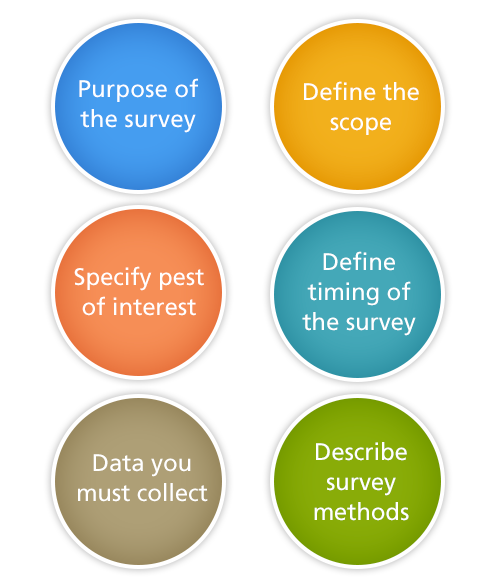Lesson 3: Phytosanitary Systems
Topic 2: Pest-Free Concepts and Pest Surveillance
This topic reviews the concepts of pest-free areas (PFA) and pest surveillance. In addition to supporting PRA, quality pest surveillance programs provide the necessary information for declaring and maintaining pest-free areas.
Objectives:
- Describe the benefit of creating and maintain PFAs.
- Recall the relationship between PFAs and pest surveillance.
- Recall the importance of pest surveillance to phytosanitary programs.
What are pest-free areas (PFAs)?
Recall, according to ISPM 4,
“A ‘pest-free area’ is an area in which a specific pest does not occur as demonstrated by scientific evidence and in which, where appropriate, this condition is being officially maintained.” —ISPM 4
In other words, a pest-free area is a specific geographic area that is currently free of a specified pest backed with data and evidence that supports the claim. There are many ways to manage pest risks, but pest-free areas have some unique advantages to facilitating agricultural trade, and thus are desirable to create and maintain when appropriate conditions are met. For export, a PFA can sometimes be used as an alternative to a systems approach where two or more measures are required to sufficiently lower the pest risks. Established PFAs can be used as a stand-alone measure, eliminating the extra phytosanitary measures thus making export more efficient and cost-effective. For imports, a PFA provides strong justification for requiring phytosanitary measures from the exporting country. This helps quickly settle disagreements about the necessity of increased requirements if your country is actively maintaining a PFA from the pest risk in question.
Before deciding to create and maintain a PFA, you must consider a few factors that make a PFA more or less likely to succeed. The following is a brief review of the four main factors.
Once you have considered the factors and decided a PFA is a good option, you will need to consider the operational aspects of how to create and maintain one. Below is a brief review of the procedural components of operating a PFA.
Critical to establishing and verifying a PFA is an effective pest surveillance program. Pest surveillance provides the current pest presence information needed to operate a PFA.
Pest Surveillance
As mentioned previously, you need an effective pest surveillance program in order to successfully create and maintain a PFA. In addition to pest detection for establishing a PFA, the purpose of conducting pest surveillance and monitoring also includes pest detection and compiling pest population information for use in PRA and, where appropriate, the preparation of pest lists. It is a necessary data gathering activity to provide scientific and physical evidence for regulatory decision-making.

There are two types of pest surveillance activities, general and specific. General surveillance comprises extensive research and data gathering of currently available research studies and other available pest information. Specific surveillance involves physically going out in the field to collect specimens and monitor presence of pests.
The success of general surveillance is entirely reliant on the quality of your information resources. Quality resources are traceable back to a reliable source that has been validated by other experts in that field of study. Possible resources may include NPPOs, other national/local government agencies, peer reviewed scientific articles, research institutions, universities, scientific societies (including amateur specialists) producers, consultants, museums, the general public, current observations from scientific and trade journals, unpublished data from scientists, and international sources such as FAO and RPPOs. Some of these resources are more reliable and authoritative than others, but the important thing to keep in mind is that any source used needs to be clearly referenced so that anyone could follow the trail back to the original source.
Specific surveillance is used by NPPOs to obtain information about pests of concern on specific sites in an area over a defined time period. There are many benefits to performing surveys. The information obtained can be used for various purposes including:
- Aiding in early detection of new pests.
- Determining the distribution of pests and the presence/absence of pests in an area, or on a host commodity.
- Supporting NPPO establishment and maintenance of pest freedom by determining pest absence from a specified area.
- Reporting to other organizations such as RPPOs and FAO.
It is very important to clearly define the scope of specific surveillance activities because human resources and supplies are finite, and you can only cover so much ground in a limited amount of time.
In general, there are three types of specific survey.
Lastly, we will review six fundamental components of planning a comprehensive specific survey. These components are also outlined in ISPM 6. Keep in mind, the final survey plan must be approved by the NPPO. Following and completing each component during the planning stages will provide the best chance of success for your pest surveys.

Once the entire specific survey plan is created, surveyors can be sent out into the field. Surveyors must follow the procedures as outlined in the NPPO approved plan. Everything from the trap types, sampling locations, and recording methods should be outlined in the plan and followed when in the field.
Pest-free areas are a beneficial tool in any phytosanitary program. However, PFAs are not possible without a robust, effective pest surveillance program. For more details on these concepts, please review Module 7: Pest Surveillance and Module 9: Pest-Free Concepts.
To continue, select Topic 3 from the Topics menu above or click here.